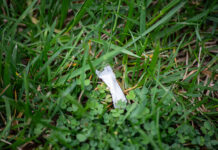Fay Malkin is a survivor – a survivor of the Holocaust, war, persecution, isolation and undeniably a survivor of fear.
In 2007, Malkin, along with two other survivors whom she had stayed with for two years in hiding, returned to No. 4 Street of Our Lady, what was once the home of Francisca Halamajowa – a Catholic woman of Polish descent who had, by the time the town was liberated, taken in 16 of the 30 Jewish survivors left in the town.
The experience, along with the survivors’ memories of the Holocaust, was recorded and turned into a film, “No. 4 Street of Our Lady,” which was released in 2011.
It was decided that the movie would be made when the diary of Malkin’s uncle, Moshe Maltz, was translated into English and published, finally allowing Maltz the chance to tell his story.
“We went back to tell our story,” Malkin said. “We needed the diary because there were four people who survived, but all of us were three, four, [and] five years old [during the Holocaust].”
Malkin began her life in what is now modern-day Sokal in the Ukraine, an area that used to be considered a part of Poland. When she was only a couple of years old, the Holocaust had already begun. At age two, Malkin’s father was taken to the brick factory in town, where he was forced to dig his own grave alongside hundreds of other men of Jewish descent, and then shot.
Soon after, in September of 1942, there was a mass roundup of Jews in Sokal. Originally, 6,000 Jews lived in the town. After the roundup, approximately 2,000 of the remaining Jews were sent to the Ghetto.
As more and more Jews were rounded up, those who refused to go easily or who tried to run were shot.
Malkin said she hid in a small cellar with 25 others in order to avoid the roundup.
Afterwards, her uncle took her family to Halamajowa, who lived only with her daughter, Helena, after she had thrown her husband out of the house on the account that he was a Nazi. Halamajowa allowed the family to stay in the hayloft of her pigsty, a wooden building situated in the back of her house. For two years, Francisca and Helena took care of the family, bringing them food and water and taking care of their waste.
Malkin said she remained in the loft until the age of four. She said she still recalls the terror of close calls and of almost being caught multiple times.
A passage from Maltz’s diary details the sacrifices that the family was prepared to make one day when Malkin would not stop crying.
Her family believed that the noise she was making would reveal their hiding place and decided that, for the greater good, Malkin had to be quieted. When words, toys and promises would not do the trick, her uncle and a doctor held her down, forcing poison into her mouth.
“I remember two people, my uncle and my doctor, holding me down… I kept saying, ‘Please, I’ll be quiet,’” Malkin said. “Did I know they were trying to kill me then? No.”
It wasn’t long before Malkin stopped crying, and stopped moving altogether. As the family went out at night to bury her body, they discovered that she was still alive.
As a young girl, Malkin did not realize or comprehend the true meaning of what had happened.
In fact, it wasn’t until a few years ago, Malkin said, that she understood the full extent of what happened that night—her own family had tried to kill her.
Malkin said this and other memories remain with her today – a reminder of her past and the struggles that she and her family faced during the Holocaust.
“I paid a price for it, and the price I paid will always be with me,” she said.
On July 19, 1944, Sokal was liberated. It was not until Malkin’s family left the hayloft that they realized Halamajowa had also been hiding a family in the cellar underneath the kitchen, and a German soldier in her attic.
Malkin said her family traveled through Europe after the liberation and moved to the United States in 1949.
“I left when I was six years old, right after the war,” she said. “My mother was the one who said we had to leave… 2007 was the first time I had been back.”
Today, Malkin works at a commercial real-estate firm in New Jersey. She has one daughter and two granddaughters; her husband passed away a few years ago. Malkin travels wherever she is invited, happily sharing her experiences in schools and communities.
“You tell your story of survival, of fighting for survival, of going on after the war… Just surviving is prevailing,” she said. “I am here. I prevailed.”







